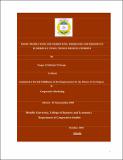| dc.contributor.author | Tsegay, G/Michael T/Giorgs | |
| dc.date.accessioned | 2014-11-25T12:23:15Z | |
| dc.date.available | 2014-11-25T12:23:15Z | |
| dc.date.issued | 2010-10 | |
| dc.identifier.citation | Tsegay G/Michael T/Giorgs (2010) Dairy production and Marketing in Mekelle Town, Tigray Region, Ethiopia, Thesis. Mekelle:MU. | en_GB |
| dc.identifier.uri | https://opendocs.ids.ac.uk/opendocs/handle/20.500.12413/5177 | |
| dc.description.abstract | Dairy production and Marketing was studied on 168 dairy farms consisting of 85 cross breed (40 medium sizes and 45 small sizes) and 83 local breed (30 medium sizes and 53 small sizes) cows owning farms in Mekelle town. Cobb-Douglas production, cost-benefit (C: B) and break-even ratios were employed to assess resource use efficiency and profitability and financial efficiency of cross and local breed dairy farms. The regression coefficients with respect to concentrate for medium and small size cross breed farms are positive and significant at 10% level. The coefficient of dry fodder for medium size cross breed and local breed are positive and significant at 10% level. For small and medium size local breed farms, the coefficient for dry fodder is positive and significant at 5% level and labor is positive and significant at 5% level in the case of small size cross breed. For small and medium size local breed farms, the coefficient for miscellaneous are positive and significant at 10% level. There is difference between the present and optimum levels of inputs. The optimum levels of inputs with respect to concentrate are 30.21 quintal and 24.82 quintals for medium and small size cross breed farms, respectively. For dry fodder, the optimum is 32.70 quintals and 12.84 quintal for medium size cross and local breed farms, respectively. where as, 8.88 quintals for small size local breed farms. Green fodder, the optimum level is 10.88 quintals for medium size local breed farms.
The optimum level for labor is 403.12 man day for small size cross breed farms. For miscellaneous cost the optimum levels are 228.54 Birr and 336.47 Birr for medium and small size local bred farms, respectively. The C:B results indicated that cross breed farms were profitable (1.0:3.02) than local breed farms (1.0:2.18). Both medium and small categories of cross breed farms were profitable (1.0:3.45 and 1.0:2.74, respectively). In local breed medium size farms were profitable (1.0:2.19). The ratio of break-even milk output from the actual milk production for cross breed and local breed cows owning farms needed 13% of the actual milk production and 18% additional milk production over the actual milk production to cover fixed cost, respectively. Cross breed small and medium size farms needed 8% and 11% milk output and local breed small and
medium size farms requires additional 31% and 14% over the actual milk production. In conclusion, dairy cow's owner should be advised to use the optimum levels inputs and replace their indigenous cow with cross breed cow. More over, the herds should be medium size and feeding mainly depends on concentrate. | en_GB |
| dc.language.iso | en | en_GB |
| dc.publisher | Mekelle University | en_GB |
| dc.rights.uri | http://creativecommons.org/licenses/by-nc-nd/3.0/ | en_GB |
| dc.subject | Agriculture | en_GB |
| dc.subject | Trade | en_GB |
| dc.title | Dairy production and Marketing in Mekelle Town, Tigray Region, Ethiopia | en_GB |
| dc.type | Thesis | en_GB |
| dc.rights.holder | Mekelle University | en_GB |


